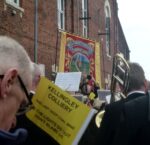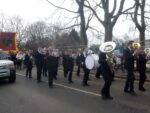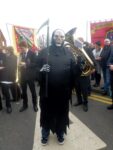When Britain’s last deep coal mine closed, I found myself conflicted* between my environmentalist, folklorist and political identities, in all of which coal miners and their industry have played an important role. My overwhelming feeling in the end was one of sadness and loss, focussed on the communities and the values they represented. Folklore, they say, is always dying out; and in this case, so it is.
The following brief look at some miners’ superstitions doubles as a short personal tribute to mineworkers and their communities.
John Billingsley
On the afternoon of December 18, 2015, 450 miners walked off the last shift at the last deep colliery in Britain. As their shadows fell on the gates of Kellingley Colliery, an old industry died; its communities and its customs and traditions, an entire traditioned lifestyle.
At 12.30 the next day, 6-7000 people came to Knottingley Town Hall, in West Yorkshire, to pay their respects to the industry and to miners past and present, and their disrespect to politicians whom they felt put share prices above communities.1 The Knottingley Silver Band, preceded by Death with his scythe, led the marchers half a mile or so through the town, past pavements thronged with well-wishers, to the Kellingley Social Club (known to the miners who used it as The Big C) for a last gathering.
It’s not through an earth mysteries lens that this event and the deep mining industry is viewed here, but a folkloric one, particularly of omens and ill fate. Communities built around dangerous work, like fishing and mining, have developed rich bodies of custom and belief. Brass bands, of course, are associated with heavy-industry workers all across the north of England and Wales particularly, as is traditional longsword dancing. The sense of workers’ community and solidarity is expressed not just through resilience during strikes like those of the 1970s2 and 1980s, but through ornate Union banners, which constitute a strand of folk art in themselves.
Such strength in community is often attributable to the constant risk of accident leading to maiming or death, or to the shared experience of working in conditions that are to us barely imaginable – a friend of mine, born at the beginning of the 20th century, worked in the Halifax mines, where seams were narrow (18-24″) and inevitably damp. He told me of crawling maybe 200 yards in low wet passages like these to reach the seam, which he hacked at with a pick; to get leverage, he had a wedge-shaped piece of wood which he placed beneath his shoulder – at least the wedge, and not his shoulder, was in the black puddle for hours at a time. What was most remarkable, for me, was that John Aked lived into his 90s, slight and wiry till the end.
Colliers soon developed a sensitivity to omens, or any sign that might create some negative association in the mind. A cross-eyed or squinting person, for instance, was bad luck to encounter on the way to the pit – this strangeness of gaze was tied up with notions of the evil eye, the conscious or unconscious projection of bad feeling towards another. It didn’t matter that the cross-eyed person may not have intended any harm at all – the crucial point was that the miner’s mind had been discomfited. That wasn’t good for concentration in a risky environment. Other omens were, naturally enough, someone in the family dreaming of death, or less naturally of damaged shoes.
Some kinds of wildlife could be ominous. Both fishermen and colliers were upset by the cry of certain birds that flock closely together, like plovers and geese, or those that cry mournfully, like the curlew. Their piping cries gave them the sobriquet the Seven Whistlers, and drew them into a seam of folklore whereby they became, for some, the souls of deceased colleagues warning of disaster; they surely overlapped with other existing traditions of the Gabriel Ratchets. The recommended course of action if they were heard was to down tools for the day, and 19th-century miners would surely know how the birds were heard were heard in a storm in September 1871, the day before a gas explosion at Ince Moss Colliery, near Wigan, killed 70 men; or how the Whistlers had been heard before a pumping engine collapse killed 204 miners at Hartley Colliery, Northumberland. Not surprising that men stayed away from a colliery in Leicestershire in 1855 because of this sound.3 But if miners didn’t like to hear the whistling in the air, they were just as cagey about whistling in the pit – an old belief suggests that whistling can call up spirits.4 Such spirits might be something like the ‘knockers’, who could alert miners to good seams or warn of an impending tunnel collapse, or sometimes cause collapses; although these boggart-like entities are primarily associated with Cornish tin miners, their lore seems to have spread to coal-miners in Wales and eastern USA.
Other birds are considered unlucky, too – pigeons, doves and robins particularly spelled danger. The Senghenydd disaster of 1913 that killed 439 Welsh miners and remains the worst of Britain’s mining accidents, was preceded by sightings of birds in the mine.
Cats were unwelcome near the pit and preferably not even mentioned – but when lots were drawn for which stretch of seam a piece-working miner would be allotted, the house cat was popped into an unlit oven for luck and/or the coal tongs placed on the mantelpiece.
Once a miner left home for work, there was one especially dreaded cause for why he might come back early from shift. If that happened, his shoes would be placed on the table as part of the laying-out procedure – that’s one reason why the rest of us don’t put shoes on tables either. Forgetfulness was also ill-omened, surely for similar reasons of concentration in a job that needed alertness. So if a miner left something he needed at home, it was bad luck to cross the threshold to fetch it – countermeasures might include knocking on the window three times and getting someone indoors to bring the item out. This superstition is also tied up with the magical and liminal nature of thresholds, never to be treated lightly.
Coal itself is a valued gift from the earth, customarily carried by first-footers at New Year to bring luck into the visited house, and given by neighbours to new tenants of a house on arrival. At other times of year it was unwise not to pick up any piece of coal you found in your path, as you would be spurning luck, which is why many people carried a lump of coal with them – particularly burglars, who procured another lump when they felt the one they had had run out of power. Ethel Rudkin in Lincolnshire reckoned there should always be a piece of coal in the Christmas stocking; and if you spat on it and burn it in the fire while holding a wish in your mind, the wish would come true.5 Iona and Peter Opie reported that children in their day (late 1950s) took a piece of coal with them into exams6 – but I wonder how many urban children now are familiar with coal in these days of central heating and smoke-free zones?
The whole nature of coal-mining is implicitly tied up with liminal notions in the communal psyche – light and dark, the underworld and its quests, beliefs about denizens of the deep earth, and even taboos against digging into the earth – and any area of mining will have developed customs that seek to nullify the riskier metaphysical elements of their job. That’s one encounter deep colliers (and those denizens) no longer have to worry about, as the last mine and its subterranean workings are buried.
The symbolic clout of coal in unsurprising. It provided warmth and light, it guaranteed jobs – if unpleasant and hazardous ones – for a community’s menfolk, livelihoods for families, and prosperity for the burgeoning enterprises of the Industrial Revolution, and it was crucial to Britain’s industrial, even naval, success. But as burglars would tell you, at some point your coal would run out of luck. That surely started to happen in Britain in the 1980s, when Prime Minister Thatcher set her own ‘evil eye’ against the unions. No government since has come bearing gifts to Old King Coal, and on December 18, 2015, luck finally ran out for British deep coal.
Notes and Sources
NB Sources often treat customs and beliefs as if they were general throughout the country. In reality, just as lead miners and tin miners had their own specific localities and traditions, coal-mining traditions can be expected to have varied between, say, S Wales and Yorkshire. So while some – like the taboo against whistling – would have been common to all kinds of miners, or current across different regions, this cannot be assumed.
- Though Kellingley, like other closed pits, still had plentiful reserves, Britain’s coal-fired power stations and homes will still burn coal, imported from thousands of miles away, mostly from Russia and Colombia, raising transport emissions questions on its own, before we even start to think about social impacts and costs. Even as an environmentalist, the reasoning seems awry to me. But what do I know, I’m not a capitalist.
- My earliest experience of picketing – I was a student at Essex University when Yorkshire miners needed to picket ports like Felixstowe, where imported coal was being brought in. I was once proud to have shaken Arthur Scargill’s hand – not sure now, though. Many miners were billeted with students in their uni accommodation; many a student drank more beer than they were used to, and many a miner was introduced to a new kind of recreational drug during those weeks of sleeping on floors.
- Christina Hole, English Folklore, Batsford 1940, p40.
- As M R James was probably aware when he wrote his ghost story, ‘Oh, Whistle, And I’ll Come To You, My Lad’.
- Iona Opie & Moira Tatem, A Dictionary of Superstitions, OUP 1989, p89.
- Iona & Peter Opie, The Lore & Language of Schoolchildren. OUP 1959, p226.
* Even more so when severe flooding submerged Cumbria, Lancashire and Yorkshire in the same week
Other sources consulted
Cooper, Quentin & Sullivan, Paul. Maypoles, Martyrs & Mayhem. Bloomsbury 1994, p40.
Haining, Peter. Superstitions, Sidgwick & Jackson 1979.
Hartley, Marie & Ingilby, Joan. Life & Tradition in W Yorkshire. Smith Settle, 1976.
McConnachie, C. www.bbc.co.uk/news/in-pictures-35115601, acc’d 20-12-15.
Radford, E & M A. Encyclopaedia of Superstitions. Hutchinson 1961.
Roud, Steve. Superstitions of Britain & Ireland. Penguin 2003.
Simpson, Jacqueline & Roud, Steve. A Dictionary of English Folklore. OUP 2000.
Smith, Alan. Discovering Folklore in Industry. Shire 1969
Photos by John Billingsley
“I think the closing is a part of the social history of Britain that is going to be gone now. There is not going to be another industry like this ever again…. it is more of a brotherhood than a job”
Chris McConnachie, Kellingley miner
Published in NE 144 (March 2016), pp21-24
https://northernearth.co.uk/subscription/








